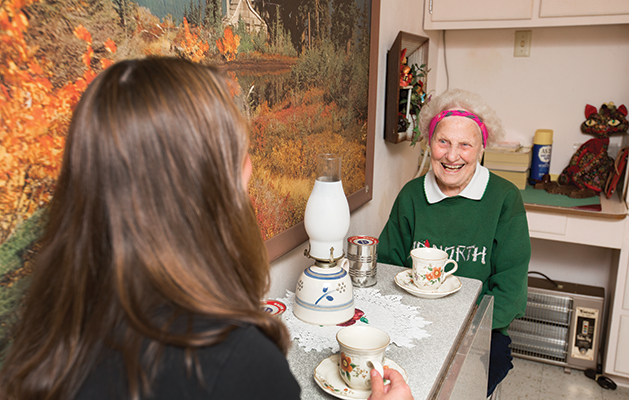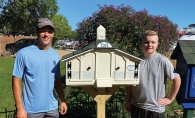
She drinks an elixir of cider vinegar, honey, warm water and a dash of lemon juice every day—she has for as long as she can remember, possibly since she was a teenager. Sometimes the vinegar shows, especially when Henrietta Chute adamantly talks about wanting to drive again after suffering a stroke, knocking the table with her fist for emphasis. The honey shows, too. It oozes sweet charm from the 94-year-old Minnetonka resident when she recalls her beloved late husband Bud, or talks about her youth. “Oh, I was game for anything; I’d try anything,” she says.
Today, she sips black coffee, sitting in her kitchen adorned with roosters and chickens. (You can take the girl out of the country, but you can’t take the country—you know the rest.) An electric coffee percolator shines on the tidy counter, where a well-used recipe holder stands in a corner, and Chloe, Chute’s pup, snoozes on the linoleum floor.
Chute was born in 1923 in Golden Valley to Cranshaw, her English father, and Lena, her German mother. She’s the lone survivor of ten siblings, one of whom was her twin. “And it’s hell. It’s hell,” she says of losing all her brothers and sisters. “I’d give anything to have them back.” David, Henry, William, Chuck, Bob, Margaret, Hazel, Dorothy and Irene—she rattles off their names like she was calling them home for supper.
Chute remembers fishing on Lake Minnetonka with her siblings and later with Curtis “Bud” Chute, her husband, who died in 1991 at 87. He’d go for the walleyes, and “I always fished for the sunnies,” Chute says. As a child, she’d swim or play Annie Annie Over. “We didn’t really play a lot. Mom had to keep track of us,” she says.
Chute’s work ethic developed early in life. “We did everything, working for peanuts,” she says, remembering how the kids would pick raspberries for 20 cents an hour, turning over the money to their mother. They also hand-harvested other produce. “We worked for all the farmers around Hopkins and Minnetonka,” she says, and like many kids of her generation, “We always worked, since we were 12 or 13 years old.”
Chute attended Groveland Elementary School through eighth grade, concluding her formal education. She eventually went to work at Minneapolis-Moline, a large tractor and machinery producer. It was there she met Bud. “He was a clown,” she says. “He was the greatest guy.” He made her laugh. “He was a Swede. The Swedes are something. They were always friendly,” she says. (The couple never had children of their own, but Chute is stepmother to Bud’s daughter, Darlene.)
Chute moved in 1955 to IBM, where she worked for 30 years. “It was wonderful. They were so good to me,” she says. By 1957, the couple purchased their Minnetonka home for $24,900. At the time, it was the last house on the street; today, homes stretch far beyond it on either side of the street.
In her yard, Chute often holds court with her neighbors, including Tim and Meg Reichel and their children Sam, 15, and Emma, 10. “Everyone knows Henrietta,” Meg Reichel says. “She loves to visit.” And she loves to share tidbits about the area. “If you need to know anything about the neighborhood, she knows it,” Reichel says. “She’s the neighborhood historian.”
The Reichels first met Chute years ago while delivering May Day baskets, and Meg stops by a few times a week to chat. Even though Chute was mowing her lawn and shoveling snow well into her 90s, she eventually agreed to let Sam Reichel take over the duties. “She felt it was important to give back to the neighborhood and allow Sam to do the work,” Meg says.
While she’s accepted help in some areas of her life, Chute continues to capably man the helm. “She’s always taken care of herself and is quite comfortable to do so,” Meg Reichel says, later adding, “She’s an inspiration. This is how we all want to live through our 90s.” The value of having a neighbor like Chute isn’t lost on Reichel, and her children learn something new with each visit. “Every time the kids go over, she has something new and interesting to show them,” she says.
In addition to the working greenhouse, Bud’s ham radio collection and plentiful photos from her past, the pièce de résistance of Chute’s home has to be the fallout shelter. To get there, journey down two floors—and back in time. Henrietta and Bud built the shelter in 1961. “IBM gave all their employees $1,000 to build one,” Chute explains. “Bud loved to build things, and he drew it all to scale.”
The shelter’s entrance is marked by a wooden wall ladder, which runs up to an escape hatch leading to the backyard. Bud, ever the planner, mounted a peg board nearby to hold a hammer, sledgehammer and wrench—at the ready to open the hatch, which opens near an unassuming container of blooming geraniums in the backyard. The circular metal rim of the hatch barely peeks through the grass.
The shelter itself could double as a mid-century efficiency apartment in New York City. A hotplate and electric frying pan ensure hot meals—if the electricity holds on, that is. A wall mural above a table for two was Bud’s answer to a nice view, in lieu of a window. Tidy bunkbeds await, as does ample cupboard space. A pink poodle toilet seat cover with matching shower curtain and hand soap pertly stand at the ready for any sort of weather or manmade disaster. Chute remembers using the shelter the first night it was completed, when five tornados dropped into the area. “We didn’t really sleep very much,” she says.
Interestingly, Chute still has some of the multipurpose food (MPF) cans from General Mills. In a pinch (or a catastrophic bomb blast), two ounces of MPF with toasted soy grits, calcium carbonate and other ingredients provide 40 percent of the daily-recommended protein—at least it did back in the day. A handful of canned water remains, too.
Our visit circles back to Chute’s kitchen, where her thoughts return to life in today’s world. She’s puzzled by some modern attitudes. “People don’t know enough to come out of the rain,” she says. Though she was a longtime IBMer, most technology leaves her unimpressed. “All I have is a caller ID, and that doesn’t work,” she says with a chuckle.
A stroke last year sidelined Chute a bit. “This one doesn’t work like it should,” she says, opening and closing one of her hands. “That’s the stroke part, but I’ll get it back.” And she’s determined to get back on the road. “I want my car. I want to keep driving,” she says, reminding herself aloud to call her doctor to see if he’ll give her the green light. Chute’s brother, David, taught her to drive. “He was my pal. He did everything for us. He was more of a dad for us,” she says. Chute paid 50 cents for her first driver’s license and purchased her first car, a ’37 Ford, for $285. She paid $20 a month for it and loved every last nickel of it. “I’d give anything to have that back,” she says.
The calendar on Chute’s kitchen table tracks her week—a visit with Lake Minnetonka Magazine today, volunteering at the senior center tomorrow, and Friday brings an appointment to have a wisdom tooth removed. When she isn’t visiting with neighbors or getting out and about, Chute loves listening to country music—Don Williams, to be precise. “He puts me to sleep every night,” she says.
Chute could keep the conversation running, but as the kitchen clock approaches noon, it’s time for one of her favorite programs, Polka Spotlight on Metro Cable Channel 6. She loves the tempo of the dance—and the rhythm of her long Minnetonka life.









